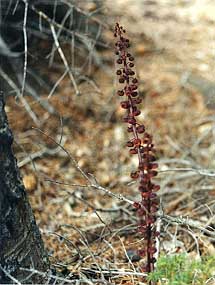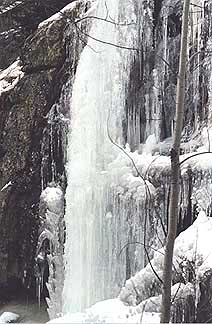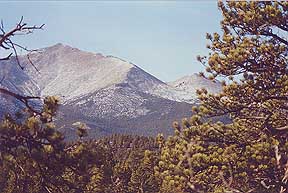
A November day close to Thanksgiving, after a rugged and lengthy cold snap, wakens to warming sunshine. Calm air. Brilliant blue sky. There are eight of us together on a retreat at Pete's cabin.
I have written this verse to guide our group to the beginning of a trail of special readings and landscapes. Down the curving, narrow dirt road where snow lies in tree shadows and has been packed in tire tracks to glissade-smoothness, the rose hips (fruit) on thin-thorned branches remind us of summer's deep pink blossoms.
At the bottom of the hill a rock face - maybe twelve feet high - sports a neatly painted "NO HORSES" at its top, well above eye level even astride a horse. Whether it refers to the road and the trail or just the trail is unclear. But no matter. We have only shanks' mares.
Left of the outcrop a path leads northward along the creek that empties this narrow valley's watershed. I placed Wendell Berry here - writing about looking at the stream valley from his farmhouse window and remembering the many forms of wildlife that he's seen there and wondering how to protect it from the quick ravage of a developer's bulldozer.
The one thing that I know above all is that even to hope to protect it, I have got to break out of all the categories and confront it as it is; I must be present in its presence....We are all what we are partly because we are here and not in another place....I have been trying to learn a language particular enough to speak of this place as it is and of my being here as I am. ... But when I try to make my language more particular, I see that the life of this place is always emerging beyond expectation or prediction or typicality, that it is unique, given to the world minute by minute, only once, never to be repeated. And then is when I see that this life is a miracle, absolutely worth having, absolutely worth saving.
Wendell Berry: Life is a miracle; Orion Magazine, Spring 2000
Berry has farmed in his home place in Kentucky for nearly forty years, together with being much more...a college professor, a writer of import on agriculture and on the ethics of land use, a poet.
It is unquestionable that the place we live in has much to do with our own on-going creation.
The stream is maybe six feet across, amply covered by smooth grey ice - the grey of a Vermont overcast sky in November. Underneath, the water still flows swiftly and, at this particular curve, chuckles and gurgles in a deeper tone, loudly proclaiming its energy.
Clouds of evergreen kinnikinnick plants - bearberry - Arctostaphylos uva-ursi - mat the ground with rounded leaves and red berries. A close group of conifers line the trail, shielding it from the few inches of snow that lie elsewhere and shadowing it from the low-hung sun.
Thoreau waits here by the deep red stalks of saprophytes. 
I enter some glade in the woods, perchance, where a few weeds and dry leaves alone lift themselves above the surface of the snow, and it is as if I had come to an open window. I see out and around myself....This stillness, solitude, wildness of nature is a kind of thoroughwort, or boneset, to my intellect. This is what I go out to seek. It is as if I always met in those places some grand, serene, immortal, infinitely encouraging, though invisible, companion, and walked with him.
Quotations of Henry David Thoreau, chosen by Eliot Porter in In Wildness Is The Preservation of the World, Sierra Club Books [Thoroughwort and boneset are healing herbs.]
Going to places that are more or less natural (it certainly doesn't have to be wild) does provide healing to people. This day we are not in wilderness; there are camps on both ridges above the brook, but.... there are no sounds of motors except occasional airplanes; there is nothing loud and distracting. Quiet...sometimes I think it is the greatest healer, particularly when experienced in places where human hands have not wrought much.
Providing a footbridge for squirrels, the silvery, barkless bole of a tree lays across the stream. Purposeful or happenstance, it matters not. We appreciate the echoing of the grey ice below...the solid water. Further along, on the other side of the trail, the lichen fount has deep reds, pale greens, mustardy yellows, bluish greys - all hosted by a partly buried granitic chunk.
Rick Bass welcomes us to the valley of the Yaak, of which our tiny valley is a faint echo:
The chief attribute of the Yaak's magic, I think, is a resonance: the depth of a chord being struck within the human essence. One of the effects of this resonance, I've noticed, is that it stirs the imagination and the creative spirit. Art-the desire to make order and meaning out of otherwise random elements, just as a landscape takes its alpha and beta diversities to weave a gamma-is a common response to entering a landscape that has this undefinable feel to it. It's a chord that gets struck deep and often, in the Yaak....I think it is the responsibility of art to name the presence of what is valuable, and to guard and celebrate it-even if only with stories-until such time as scientists or others find a way to assess the rarity of such mysterious places.....
Rick Bass, The Raccoons of Yaak, Orion Magazine, Spring 1999
When people started using art to depict the mysterious and the wonders of wild places, the mysteries and wonders received protection in many cases. Yellowstone National Park is the prime example in our American history. Without the paintings of Thomas Moran and the photographs of William Henry Jackson presented to the Congress in 1871-2, would the legislation establishing it have happened? I think it would have been a longer struggle if only words had described it.
 Trail and creek lead to a narrows where a sheer rock ledge lines the west side of the stream. The cold November weather has created a special treat as springs on top of the ledge seeped down over the face and froze layer after layer to form a thick, light-glistening icefall. The stream undercuts the ledge and water dripping from that low ceiling has built stalagmite icicles on the frozen water.
Trail and creek lead to a narrows where a sheer rock ledge lines the west side of the stream. The cold November weather has created a special treat as springs on top of the ledge seeped down over the face and froze layer after layer to form a thick, light-glistening icefall. The stream undercuts the ledge and water dripping from that low ceiling has built stalagmite icicles on the frozen water.
The sun fills this little glen with soft, warm light as we settle on the bench to hear Jane Goodall describe a moment:
Lost in awe at the beauty around me, I must have slipped into a state of heightened awareness. It is hard-impossible, really-to put into words the moment of truth that suddenly came upon me then. It seemed to me, as I struggled afterward to recall the experience, that self was utterly absent: I and the chimpanzees, the earth and trees and air, seemed to merge, to become one with the spirit power of life itself. The air was filled with a feathered symphony, the evensong of birds. I heard new frequencies in their music and also in the singing insects' voices-notes so high and sweet I was amazed. Never had I been so intensely aware of the shape, the color of the individual leaves, the varied patterns of the veins that made each one unique.
Jane Goodall: In the forests of Gombe; Orion Magazine, Spring 2000
That exquisite quality of being so into the natural surroundings and so out of one's mind that one knows no separation between self and not-self, no separation between human body and not-human body...if each human being on this planet could experience that quality just once...and remember it for the rest of their lives...we would know peace.
We, sitting there on the bench, are unable to pinpoint such an experience in each of our lives, and we lament our seeming inability to even put ourselves in a place to do so. But the sunshine, the delectable vision of water and temperature magic...no one wants to leave this place where the water gurgles are dampened to murmurs under the snow-covered ice.
Away from the brook and across a small meadow to a stack of wood chunks near two well-grown ponderosa pines. One is free, untrammelled. The other is wrapped with a cable held off the bark by strips of wood. The cable is guyed to the ground on the east side of the tree while the other side is attached to another cable which runs across the meadow, the brook, and rises to a tree atop the ledges on the other side. A "path" to get from up there to down here quickly. At what cost to the tree? Are there turn-bolts to allow expansion? Unlikely. If the cable is left there, the tree will grow over it, perhaps...I suspect it will feel slightly suffocated for a long time.
This human-made (although I suspect "man-made" would be more correct) intrusion reminds us that even the smallest of our actions creates an impact. These "twin" trees will not continue growing at the same rate if the cable is left around the one for too long. Every choice we make affects something somewhere else. And we "make" so many mindless choices. Laura Sewall illustrates how each individual can be rethink their choices:
The central work of the visionary is to strengthen the image that she can "get behind," the one that is backed up by heart and soul. The image she carries will be renewed and refined with each attendant gaze, and with each careful visualization. Over time the image intensifies, now informing her daily choices, her often unconscious movements toward that with which she resonates. The image she holds shifts her course, steering her as if by an invisible wind.
Laura Sewall: Reversing the World, Orion Magazine, Autumn 1999
Perhaps that is where we (the retreat group), as wildness advocates, slip a little. Our daily energy is poured into activities which sometimes bring us the results we think are best, but contemplative visualization of our ultimate desired results is given short or no shrift. (I can see it now - along with weekly staff meetings, we'll have weekly staff meditations. Actually, not a bad idea.)
 It's a short hill, but it suffices to bring us out of the narrow valley where the mountains to the west have been hidden from us. At the small, sunset-watching deck, the sweep of Mount Meeker's broad east face is reason enough to pause. Framed by embracing ridgelines, the rocks have been lightly etched with a thin snow. Tree line is low on this 14,000-footer, and what seems to be its peak is actually the slightly higher Long's Peak just behind it.
It's a short hill, but it suffices to bring us out of the narrow valley where the mountains to the west have been hidden from us. At the small, sunset-watching deck, the sweep of Mount Meeker's broad east face is reason enough to pause. Framed by embracing ridgelines, the rocks have been lightly etched with a thin snow. Tree line is low on this 14,000-footer, and what seems to be its peak is actually the slightly higher Long's Peak just behind it.
Why are mountains so visually satisfying? Why does that impact on our optic nerves and thence to our brains create feelings of peace - joy - love? If we could bottle it, would it heal the hatred in the world?
Out of her poet's soul, Terry Tempest Williams greets us:
A man or woman whose mind reins in the heart when the body sings desperately for connection can only expect more isolation and greater ecological disease. Our lack of intimacy with each other is in direct proportion to our lack of intimacy with the land. We have taken our love inside and abandoned the wild....The land is love. Love is what we fear. To disengage from the earth is our own oppression.
Terry Tempest Williams: Winter Solstice at the Moab Slough; An Unspoken Hunger
Farmers generally love their land, but at times they also leave it furrowed raw to be blown away in the winds or washed into the creeks and rivers by inopportune rains; they drastically pollute it with herbicides and pesticides; they artificially fertilize it to sustain great chunks of single variety crops. And, oddly enough, while it is difficult to change farmers' attitudes toward organic sustainability, they jumped, practically overnight, onto the genetically engineered crops' bandwagon. How - and why - did their love become so corrupted?
Odd that I just turned away from the unabridged natural world to the unnatural world of agriculture. But Wendell Berry's hanging out in the back of my head, so maybe it's not surprising, after all.
Through a grove of aspen and around a neighboring cabin, we tread through the snow and patches of kinnikinnick. The tree by Pete's cabin that harbors a hummingbird feeder during the summer is where we find the last missive. We settle on the sun-warmed rocks and ingest more words from Terry Tempest Williams:
It is time for us to take off our masks, to step out from behind our personas - whatever they might be: educators, activists, biologists, geologists, writers, farmers, ranchers, and bureaucrats - and admit we are lovers, engaged in an erotics of place. Loving the land. Honoring its mysteries. Acknowledging, embracing the spirit of place - there is nothing more legitimate and there is nothing more true. ...I believe that out of an erotics of place, a politics of place is emerging. Not radical, but conservative, a politics rooted in empathy in which we extend our notion of community, as Aldo Leopold as urged, to include all life forms-plants, animals, rivers, and soils. The enterprise of conservation is a revolution, and evolution of the spirit.
Terry Tempest Williams: Yellowstone: The Erotics of Place; An Unspoken Hunger
The story of Julia Butterfly Hill seems to me to be a prime example of stepping out behind a mask and embracing the spirit of place. I have not yet read her book, The Legacy of Luna: The Story of a Tree, a Woman, and the Struggle to Save the Redwoods, but I have read an article which she wrote during the years above the ground.
Luna is the name of the giant redwood tree in which she lived for more than two years, in order to stop the logging of the old-growth redwoods surrounding it. She came down several months ago, after reaching an agreement with the timber company that owned the area, an agreement which would protect at least a small portion around Luna. Just this past week, Luna was in the news again, when someone took a chainsaw and cut about a quarter of the way through the trunk. Local forestry officials and the timber company worked frantically to provide stability to the trunk just before a major storm hit. Julia said it felt as if she had been raped. And I wouldn't say that such a thought was not in the mind or minds of the sawyers.
I don't think that Julia even remotely imagined that she would be living in a tree for more than two years when she first climbed into it as part of a logging protest. But one day became three, became three weeks, became three months, until her final choice was to remain Luna's lover. Staying, in spite of cold Pacific coast storms and physical threats, staying until protection was achieved.
For the most part, people evince an uneasiness, a "yeah, right" attitude, when someone speaks of a tree as having a sentient spirit which speaks to them. And yet, where is it written that trees are merely lumps of carbon, nitrogen, oxygen, and minerals? Ahh, hark back to the Ents of J.R.R. Tolkien's imagination.
We would do well to honor the mysteries of trees, animals, water, lichens, rocks, earthworms, bacteria...all of the world which it has been beyond human capability to create. For even if we are able to clone DNA and to combine different species' genes, behind that DNA and those genes still lies a creation not of human hands. We would do well to remember that we were never the beginning, and, I suspect, we will not be the ending.
Truly,
Cherie
Table of Contents
Letter to the Author: